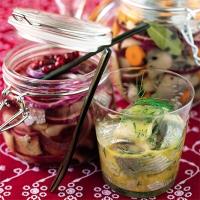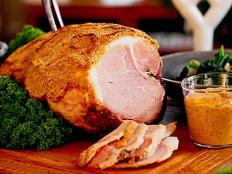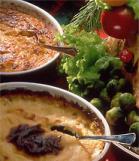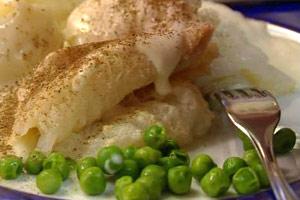Common Scandinavian Food found at our Christmas Party
In the following we have listed some Scandinavian delicacies commonly found on a Julbord (“Christmas Smörgåsbord”). Click here for a list of our suggested dishes for the annual christmas party.
Gravlax
 Gravlax or gravad lax (Swedish), gravet laks (Danish), gravlaks (Norwegian, Danish), graavilohi (Finnish), graflax (Icelandic) is a Nordic dish consisting of raw salmon, cured in salt, sugar, and dill. Gravlax is usually served as an appetizer, sliced thinly and accompanied by hovmästarsås (also known as gravlaxsås), a dill and mustard sauce, either on bread of some kind, or with boiled potatoes. During the Middle Ages, gravlax was made by fishermen, who salted the salmon and lightly fermented it by burying it in the sand above the high-tide line. The word gravlax comes from the Scandinavian word grav, which literally means “grave” or “to dig” (in Swedish, Norwegian, Danish, Dutch and Estonian), and lax (or laks), which means “salmon”, thus gravlax means “buried salmon”.
Gravlax or gravad lax (Swedish), gravet laks (Danish), gravlaks (Norwegian, Danish), graavilohi (Finnish), graflax (Icelandic) is a Nordic dish consisting of raw salmon, cured in salt, sugar, and dill. Gravlax is usually served as an appetizer, sliced thinly and accompanied by hovmästarsås (also known as gravlaxsås), a dill and mustard sauce, either on bread of some kind, or with boiled potatoes. During the Middle Ages, gravlax was made by fishermen, who salted the salmon and lightly fermented it by burying it in the sand above the high-tide line. The word gravlax comes from the Scandinavian word grav, which literally means “grave” or “to dig” (in Swedish, Norwegian, Danish, Dutch and Estonian), and lax (or laks), which means “salmon”, thus gravlax means “buried salmon”.
↑Back to list of food items↑
Janssons Frestelse (“Jansson’s Temptation”)
 Janssons frestelse is a traditional Swedish casserole made of potatoes, onion, pickled sprats, bread crumbs and cream. It is commonly included in a Swedish julbord, but can be eaten on other occasions as well. The recipe is often mistranslated into English, with anchovies being substituted for sprats. This is because sprats (Sprattus sprattus) pickled in sugar, salt and spices have been known in Sweden as ansjovis since the middle of the 19th century, while true anchovies (Engraulis encrasicolus) are sold in Sweden as sardeller (sardelles). It has often been claimed that the name originated with the opera singer Pelle Janzon (1844-1889), remembered as a gourmand. The dish is also very popular in Finland as Janssonin kiusaus, which also means literally “Jansson’s temptation”.
Janssons frestelse is a traditional Swedish casserole made of potatoes, onion, pickled sprats, bread crumbs and cream. It is commonly included in a Swedish julbord, but can be eaten on other occasions as well. The recipe is often mistranslated into English, with anchovies being substituted for sprats. This is because sprats (Sprattus sprattus) pickled in sugar, salt and spices have been known in Sweden as ansjovis since the middle of the 19th century, while true anchovies (Engraulis encrasicolus) are sold in Sweden as sardeller (sardelles). It has often been claimed that the name originated with the opera singer Pelle Janzon (1844-1889), remembered as a gourmand. The dish is also very popular in Finland as Janssonin kiusaus, which also means literally “Jansson’s temptation”.
↑Back to list of food items↑
Inlagd Sill (“Pickled Herring”)
 Pickled herring is a delicacy in Europe, and has become a part of Baltic, Nordic, Dutch, German, Eastern Slavic and Jewish cuisine. Most cured herring uses a two-step curing process. Initially, herring is cured with salt to extract water. The second stage involves removing the salt and adding flavorings, typically a vinegar, salt, sugar solution to which ingredients like peppercorn, bay leaves and raw onions are added. In recent years also other flavors have been added due to foreign influences. However, the tradition is strong in Denmark, Sweden, Finland, Norway, The Netherlands, Iceland and Germany. Onion, sherry, mustard and dill are some of the traditional flavourings. In the Nordic countries and Germany, once the pickling process is finished and depending on which of the dozens of classic herring flavourings (mustard, onion, garlic, lingonberries etc.) are selected, it is eaten with dark rye bread, crisp bread, sour cream, or potatoes. This dish is common at Christmas, Easter and Midsummer, where it is eaten with akvavit.
Pickled herring is a delicacy in Europe, and has become a part of Baltic, Nordic, Dutch, German, Eastern Slavic and Jewish cuisine. Most cured herring uses a two-step curing process. Initially, herring is cured with salt to extract water. The second stage involves removing the salt and adding flavorings, typically a vinegar, salt, sugar solution to which ingredients like peppercorn, bay leaves and raw onions are added. In recent years also other flavors have been added due to foreign influences. However, the tradition is strong in Denmark, Sweden, Finland, Norway, The Netherlands, Iceland and Germany. Onion, sherry, mustard and dill are some of the traditional flavourings. In the Nordic countries and Germany, once the pickling process is finished and depending on which of the dozens of classic herring flavourings (mustard, onion, garlic, lingonberries etc.) are selected, it is eaten with dark rye bread, crisp bread, sour cream, or potatoes. This dish is common at Christmas, Easter and Midsummer, where it is eaten with akvavit.
↑Back to list of food items↑
Köttbullar (“Meatballs”) and other Meat Dishes
 In Scandinavian cuisine köttbullar are made with ground beef or a mix of ground beef, pork and sometimes veal, mixed with breadcrumbs soaked in milk and finely chopped (fried) onions, some broth, and, occasionally, cream. They are seasoned with white pepper or allspice and salt. Meatballs are traditionally served with gravy, boiled potatoes, lingonberry jam, and sometimes fresh pickled cucumber. Norwegians also like to add fried/caramelized onion on the side. Traditionally, meatballs are small, measuring one inch in diameter.
In Scandinavian cuisine köttbullar are made with ground beef or a mix of ground beef, pork and sometimes veal, mixed with breadcrumbs soaked in milk and finely chopped (fried) onions, some broth, and, occasionally, cream. They are seasoned with white pepper or allspice and salt. Meatballs are traditionally served with gravy, boiled potatoes, lingonberry jam, and sometimes fresh pickled cucumber. Norwegians also like to add fried/caramelized onion on the side. Traditionally, meatballs are small, measuring one inch in diameter.
↑Back to list of food items↑
Other typical dishes include Prinskorv (“Small Smoked Sausages”), Frikadeller (“Danish meatballs”), Flæskesteg (“pork roast”), Pinnekjoett (“lamb ribs”) and Svinneribbe (“pork ribs”).
Julskinka (“Salt Cured Christmas Ham”)
 The main dish served on Christmas Eve is the Julskinka, the traditional Christmas ham. A Julskinka is first cured in salt brine. But then the roads diverge. Some claim it has to be boiled and some claim it has to be baked. Traditionally the baked version was covered in a rye dough crust. Today one usually uses aluminum foil. Once the ham is fully cooked the rind is removed and the a glaze consisting of mustard, egg yolk and breadcrumbs is applied. A ham should last at least for a week and appear at almost all meals between Christmas Eve and New Years Day. A traditional Julbord starts with bread dipped in ham broth.
The main dish served on Christmas Eve is the Julskinka, the traditional Christmas ham. A Julskinka is first cured in salt brine. But then the roads diverge. Some claim it has to be boiled and some claim it has to be baked. Traditionally the baked version was covered in a rye dough crust. Today one usually uses aluminum foil. Once the ham is fully cooked the rind is removed and the a glaze consisting of mustard, egg yolk and breadcrumbs is applied. A ham should last at least for a week and appear at almost all meals between Christmas Eve and New Years Day. A traditional Julbord starts with bread dipped in ham broth.
↑Back to list of food items↑
Rödkål (“Red Cabbage”), Långkål (“Green Cabbage”), Brunkål (“Brown Cabbage”) and Surkål (“Sauerkraut”)
 These are traditional Christmas dishes all over Scandinavia. They are, however, prepared in different ways. Red cabbage is sauted with apples, syrup and cloves. Långkål is traditionally chopped and boiled in the Julskinka broth. Brunkål is prepared by cooking white cabbage together with syrup.
These are traditional Christmas dishes all over Scandinavia. They are, however, prepared in different ways. Red cabbage is sauted with apples, syrup and cloves. Långkål is traditionally chopped and boiled in the Julskinka broth. Brunkål is prepared by cooking white cabbage together with syrup.
↑Back to list of food items↑
Lanttulaatikko (“Rutabaga Casserole”) and Porkkanalaatikko (“Carrot Casserole”)
These are traditional Finnish Christmas dishes. Lanttulaatikko is made with rutabaga, breadcrumbs and syrup and Porkkanalaatikko is made with carrots and rice.
Other traditional vegetable dishes include Brunede Kartofler (“sugar-browned potatoes”) and Rødbedtsalat (“red beet salad”).
↑Back to list of food items↑
Brunost (“Brown Cheese”)
 Brunost or mesost is a brown Scandinavian whey cheese. The Norwegian name brunost means brown cheese, and the other means simply whey cheese. Brunost is made by boiling a mixture of milk, cream and whey carefully for several hours so that the water evaporates. The heat turns the milk sugar into caramel which gives the cheese its characteristic taste. If boiled for a shorter time than usual, one gets the spreadable version called prim in Norwegian (or messmör in Swedish and mysingur in Icelandic), similar to Dulce de leche. Prim had been made in Norway for a long time when Anne Haav, a farmer’s wife in Gudbrandsdalen, got the idea of putting cream into the cheese and invented the Fløtemysost. She found that the cheese was better and easier to cut by increasing the percentage of fat by the addition of cream. She received a good price for her new cheese, and this merchandise is said to have saved the Gudbrandsdalen financially in the 1880s. In 1933, when Anne Haav was 87 years old, she was awarded the King’s Medal of Merit in silver.
Brunost or mesost is a brown Scandinavian whey cheese. The Norwegian name brunost means brown cheese, and the other means simply whey cheese. Brunost is made by boiling a mixture of milk, cream and whey carefully for several hours so that the water evaporates. The heat turns the milk sugar into caramel which gives the cheese its characteristic taste. If boiled for a shorter time than usual, one gets the spreadable version called prim in Norwegian (or messmör in Swedish and mysingur in Icelandic), similar to Dulce de leche. Prim had been made in Norway for a long time when Anne Haav, a farmer’s wife in Gudbrandsdalen, got the idea of putting cream into the cheese and invented the Fløtemysost. She found that the cheese was better and easier to cut by increasing the percentage of fat by the addition of cream. She received a good price for her new cheese, and this merchandise is said to have saved the Gudbrandsdalen financially in the 1880s. In 1933, when Anne Haav was 87 years old, she was awarded the King’s Medal of Merit in silver.
↑Back to list of food items↑
Fårfiol (“Smoked Leg of Lamb”)
Fårfiol is a traditional Scandinavian dish. A leg of lamb is salted, dried and smoked – preferrably with Juniper. This method of preparing this dish goes back to Viking age.
↑Back to list of food items↑
Lutefisk (“Lye Fish”)
 Lutefisk is a traditional dish of the Nordic countries and parts of the Midwest United States. It is made from aged stockfish or dried/salted whitefish and lye (lut). It is gelatinous in texture, and has an extremely strong, pungent odor. The origin of lutefisk is unknown. Legends include the accidental dropping of fish into a lye bucket or sodden wood ash containing lye under a drying rack. Another claims the practice enabled storing fish outdoors. Cold temperature acted as a preservative and the lye deterred wild animals from eating the fish. Folklore holds that lutefisk originated during the Viking pillages of Ireland, when St. Patrick sent men to feed spoiled fish to the Viking raiders. When the raiders were found to enjoy the spoiled fish, St. Patrick ordered his men to pour lye on the fish, with the hope of poisoning the Vikings. However, rather than dying from ingestion of spoiled fish, or of subsequent poisoning of the spoiled fish, the Vikings declared lutefisk a delicacy. This is obviously a fairy tale, since St. Patrick was in Ireland about three centuries before the Vikings’ arrival.
Lutefisk is a traditional dish of the Nordic countries and parts of the Midwest United States. It is made from aged stockfish or dried/salted whitefish and lye (lut). It is gelatinous in texture, and has an extremely strong, pungent odor. The origin of lutefisk is unknown. Legends include the accidental dropping of fish into a lye bucket or sodden wood ash containing lye under a drying rack. Another claims the practice enabled storing fish outdoors. Cold temperature acted as a preservative and the lye deterred wild animals from eating the fish. Folklore holds that lutefisk originated during the Viking pillages of Ireland, when St. Patrick sent men to feed spoiled fish to the Viking raiders. When the raiders were found to enjoy the spoiled fish, St. Patrick ordered his men to pour lye on the fish, with the hope of poisoning the Vikings. However, rather than dying from ingestion of spoiled fish, or of subsequent poisoning of the spoiled fish, the Vikings declared lutefisk a delicacy. This is obviously a fairy tale, since St. Patrick was in Ireland about three centuries before the Vikings’ arrival.
↑Back to list of food items↑
Desserts
Traditional desserts include dishes such as Ris a la Mande (“rice Pudding with cherry sauce”), Sekahedelmäkeitto (“fruit soup”), Riskrem (“rice cream”), Pepparkaka (“gingerbread cake”), Småkager (“cookies”), Kager (“cakes”), Peberkaker (“ginger snaps”), Lussekatter (“St. Lucy buns”) and Kransekake (“Norwegian almond ring cake”).
↑Back to list of food items↑